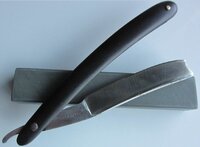timwcic
"Look what I found"
Everyone is out of the house and finally quite. Time to work off the pumpkin pie and spend some quality time with the 1K. Setting the bevels on a Sheffield variety pack of near wedges, pair of W&B, a Wosty and a Southern & Richardson Finger Ring. Rolled, circled, and torqued a tree topping bevel out of them. Will go to the 3 and 8K next peaceful moment.



